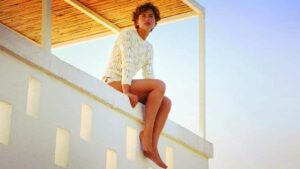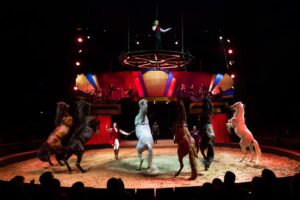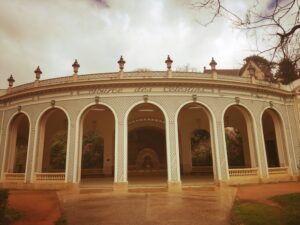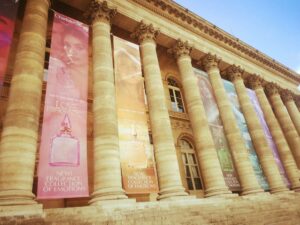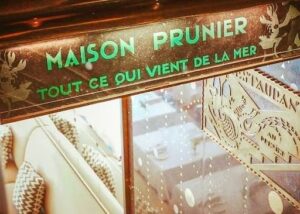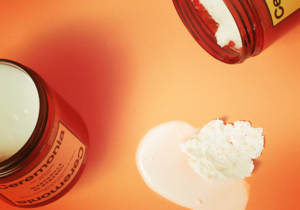Le Plateau welcomes the colourful swiss artist Stéphane Dafflon
10 min read
For his first solo concept exhibition “U+25A6” at “Le Plateau”and indeed at a Parisian institution, Swiss artist Stéphane Dafflon entirely rethinks the various areas at le plateau with an architectural and pictorial dimension, creating a whole new series of artworks encompassing paintings, sculptures and wall stickers. This presentation and these works change our perception of reality through the artist’s sphere of abstraction, until April 15th 2018.
Wall stickers boasting a plethora of infinite colours and shades fill the space with the power of vibration like a wave resonating with the surrounding architecture.
Created on a computer to begin with and then transposed to a canvas or wall, Stéphane Dafflon’s pictorial work is always designed with a specific place or architecture in mind. It is incorporated within his work and his actions change the audience’s perception of it, visually and physically.
The long chromatic variation of shades displayed in Stéphane Dafflon’s wall installation brings an impression of movement to the different areas at le plateau and feelings experienced by visitors reflect a certain affinity with the world of music.
 Stéphane Dafflon has also been creating abstract sculptural works for several years, notrestricting himself to paint. Different materials such as wood, translucent Plexiglas and stainless steel are used to produce these three-dimensional works. Painted or shimmering, these 3D objects echo the shapes of the paintings hung on the walls causing reflections, interacting with the surroundings and opening the space out to unexpected perspectives (AM012-AM013-2017-©-Courtesy-Stéphane-Dafflon-et-Air-de-Paris-Paris-1).
Stéphane Dafflon has also been creating abstract sculptural works for several years, notrestricting himself to paint. Different materials such as wood, translucent Plexiglas and stainless steel are used to produce these three-dimensional works. Painted or shimmering, these 3D objects echo the shapes of the paintings hung on the walls causing reflections, interacting with the surroundings and opening the space out to unexpected perspectives (AM012-AM013-2017-©-Courtesy-Stéphane-Dafflon-et-Air-de-Paris-Paris-1).
These transformed spaces create uninhibited visual rhythmics (originating in and detached from the pictorial theories of Max Bill in particular), combining objects, paintings and drawings with wall stickers that communicate with each another like multiple perspectives with painstakingly chosen and calibrated colours emphasising a graphic dimension with the architecture.
Through this visual assemblage of painting, sculpture, object and architecture, Stéphane Dafflon’s work portrays an original and radical vision of abstract painting, painting in the broad sense, conceived beyond media deemed as traditional such as a canvas and its frame to instigate a spatial and colourful conversation positioning the viewer at the heart of a veritable pictorial arrangement.
To better discover the artist, we propose an interview between Stéphane Dafflon and Xavier Franceschi (director of the FRAC île-de-france and curator of the exhibition)
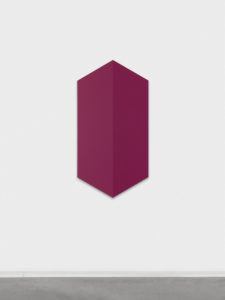 You know le Plateau quite well since you participated in the group exhibition “Un mural, des tableaux” in 2015. Already on that occasion, you devised an intervention* thatspread throughout the entire exhibition space. What were your first thoughts when I invited you back to le Plateau for a solo exhibition?
You know le Plateau quite well since you participated in the group exhibition “Un mural, des tableaux” in 2015. Already on that occasion, you devised an intervention* thatspread throughout the entire exhibition space. What were your first thoughts when I invited you back to le Plateau for a solo exhibition?
The fact that I had already used all the walls of the venue initially prompted me to think of a work that would avoid the walls and essentially unfold on the ceiling or on the floor. This proposition seemed tempting as it would have offered visitors a different way to approach my work. But eventually this project proved too complicated to implement in terms of material, so after studying the current layout of the space, it felt more appropriate to revert to a mural (AST314-2018-©-Stéphane-Dafflon-Photo.-Annik-Wetter).
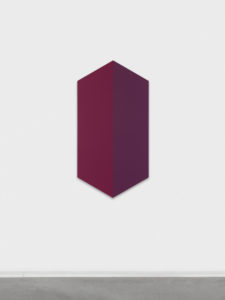 Now your work is essentially a mural, but it was devised with the entire space of le Plateau and its architectural characteristics in mind… Do you always proceed like this when asked to devise an exhibition? In other words, do you necessarily view your pictorial practice in relation to the architecture in which it unfolds?
Now your work is essentially a mural, but it was devised with the entire space of le Plateau and its architectural characteristics in mind… Do you always proceed like this when asked to devise an exhibition? In other words, do you necessarily view your pictorial practice in relation to the architecture in which it unfolds?
In most instances it depends on the location and the possibilities it offers in terms of architectural interventions. But I do indeed think of painting as forming part of an ‘installed’ environment. When I conceptualise a piece, the hanging and the surroundings in which it will be presented are just as important as the piece itself. Exhibiting allows me to develop new series related to a specific place and time. It’s a means to bring my research up to date (AST315-2018-©-Stéphane-Dafflon-Photo.-Annik-Wetter).
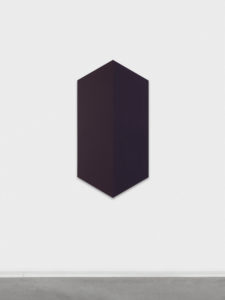 In this case, your starting point was the actual place, or, should I say, an assessment of the state of the place after the previous exhibition, a solo show by Pierre Paulin. Can you tell us more about the interventions or changes you made?
In this case, your starting point was the actual place, or, should I say, an assessment of the state of the place after the previous exhibition, a solo show by Pierre Paulin. Can you tell us more about the interventions or changes you made?
I decided to keep part of Pierre’s set-up, with the idea of creating a before and an after. I wanted to change the sequence of rooms, the way visitors walked through the space and the way the works related to each other.
The opening in the central wall allowed me to keep the existing structure, while enabling visitors to see the beginning and the end of the exhibition from this vantage point.
This gesture defined all further developments. The final decision consisted of hanging the pieces in the corners so as to create an interlocking of spaces, as in some form of Tetris. The panels in front of the windows were removed in order to let the daylight flood back into the space and thus enable a dialogue with the outside (AST317-2018-©-Stéphane-Dafflon-Photo.-Annik-Wetter).
Do you see this panoramic opening in the central wall as a sculpture in its own right?
For me it’s a sculpture, though one that is integrated directly into the architecture.
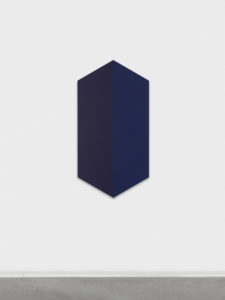 Very early on in the process, you also imagined a set of ‘all-over’ murals. In fact, these wall paintings consist of strips of printed self-adhesive vinyl. First of all, how did you design the motifs of these pieces?
Very early on in the process, you also imagined a set of ‘all-over’ murals. In fact, these wall paintings consist of strips of printed self-adhesive vinyl. First of all, how did you design the motifs of these pieces?
After having completed the architectural changes, I defined several colour charts that I wanted to use for the pieces that reappear throughout the exhibition. It seemed important to make this step visible as well (AST318-2018-©-Stéphane-Dafflon-Photo.-Annik-Wetter).
* For Un mural, des tableaux, Stéphane Dafflon was invited to present PM062, piece recently acquired by frac île-de-france.
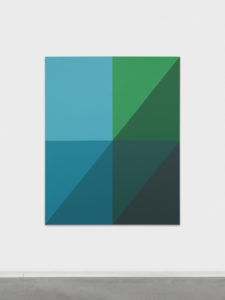 So these large strips of vinyl tape play the same role as the wall paintingsthat you had made so far. Yet which difference do you see between actual painting and mechanical production?
So these large strips of vinyl tape play the same role as the wall paintingsthat you had made so far. Yet which difference do you see between actual painting and mechanical production?
It’s a technique that I’ve used for several murals, but this is the first time that I use it in an ‘all-over’ way. The vinyl tape might be closer to wallpaper, but it’s even more so to the computer that I use at the beginning of the process. And in this case, I didn’t have to interpret the shades on my screen when preparing the actual colours.
I also use adhesive tape when I’ve got little time to implement the work. Here, the sheer number of different shades prompted me to simplify the way they would be implemented. The vinyl tape is also a means to partly evacuate subjectivity and take some distance from the colours (AST299-2017-©-Stéphane-Dafflon-Photo-Annik-Wetter).
 One of the characteristics of your artistic practice is that you systematically work on the computer before implementing the piece. Would you say that this is one of the aspects that distinguishes your work from that of your famous precursors, that is, from the abstract and geometric minimalist painters preceding you? How do you relate to them?
One of the characteristics of your artistic practice is that you systematically work on the computer before implementing the piece. Would you say that this is one of the aspects that distinguishes your work from that of your famous precursors, that is, from the abstract and geometric minimalist painters preceding you? How do you relate to them?
I see myself in a relationship of continuation in that I try to adapt their findings to topical concerns from my own daily life, and maybe using a screen is part of that (AST300-2017-©-Stéphane-Dafflon-Photo-Annik-Wetter).
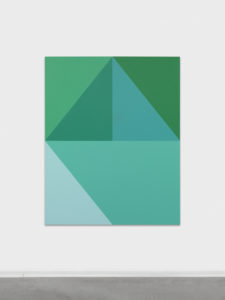 The exhibition alternates between these murals and a new series of specially produced paintings on canvas. How do these two levels play out against each other? How did you choose the motifs for these paintings?
The exhibition alternates between these murals and a new series of specially produced paintings on canvas. How do these two levels play out against each other? How did you choose the motifs for these paintings?
The motifs are divisions of a rectangle, which enable me to reconnect with the grid of the vinyl colour chart. Each painting is a possible simplification of this very division. As for the colour shades, I calibrated them based on the printed vinyl stickers, which led to a filter being applied to all the colours in the exhibition. Surprisingly, this system, which I thought was less subjective, results in compositions that refer much more obviously to existing motifs (AST296-2017-©-Stéphane-Dafflon-Photo-Annik-Wetter).
 For a while, you considered showing only murals made of vinyl tape, which would have resulted in the absence of any actual painting…
For a while, you considered showing only murals made of vinyl tape, which would have resulted in the absence of any actual painting…
Initially, I was intent on using a more industrial technique. I believe this is also a way of painting – only without gestures.
Beyond the rational construction of your work – of your murals and paintings – do you aim to unsettle or at least disturb the spectator’s perception, as in some of your previous exhibitions?
As we are conducting this interview – in other words, before the actual installation of the exhibition – it seems to me that it will be more of a play with vibrations, a more stable multicoloured work, so to speak… More stable, indeed, because there is no strong contrast. It’s the link between the succession and overlapping of works and rooms that will generate a play with perception – not the works in themselves (AST296-2017-©-Stéphane-Dafflon-Photo-Annik-Wetter).
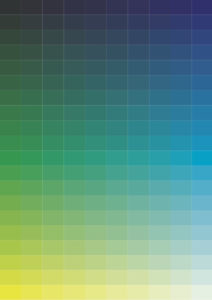 When discussing your works, people often refer to a kind of connection between art and design, and the idea that if they had any use value, it was maybe precisely because they guided visitors through the exhibition in a certain way. What would you reply to that?
When discussing your works, people often refer to a kind of connection between art and design, and the idea that if they had any use value, it was maybe precisely because they guided visitors through the exhibition in a certain way. What would you reply to that?
I don’t know if I want to guide visitors; I think I rather convey impressions, which they are free to seize upon. There are different levels on which they can read the work. As far as design is concerned, I think it has provided me with techniques, tools and models but, more importantly still, with efficient solutions when dealing with forms in the real world (AM014-AM015-2017-©-Courtesy-Stéphane-Dafflon-et-Air-de-Paris-Paris-3).
When talking about ‘vibration’, it seems legitimate to refer to the field of music and sound. You frequently point out this parallel when talking about your work. Will this also be the case in your work at le Plateau?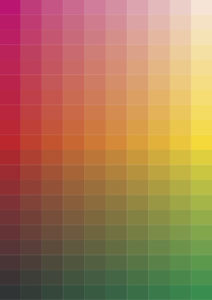
Rather than ‘vibration’, I like the idea of rhythm, of visual sound. With regard to the corner pieces, I like to think of a wave of echoes flowing from one corner to the next.
We talked about sculpture earlier, and it turns out you are also presenting new sculptures that are
directly related to the paintings in the exhibition. Can you tell us how they came about?
They’re elementary sculptures consisting of tubular frames, simple geometric forms held together with
magnets. Their role is to complement the exhibition as a whole, to accentuate the link between the paintings and the vinyl stickers, while also referring to earlier paintings (AM012-AM013-2017-©-Courtesy-Stéphane-Dafflon-et-Air-de-Paris-Paris-3)
 This is funny, because here, this play with deconstruction and reconstruction, which is a recurrent feature in your work, takes on another dimension . . . To return to your work between space and colour perception, there is one piece that fully partakes in this unique relationship, though in a different way, namely, through the intervention of light. Can you tell us a few words about this?
This is funny, because here, this play with deconstruction and reconstruction, which is a recurrent feature in your work, takes on another dimension . . . To return to your work between space and colour perception, there is one piece that fully partakes in this unique relationship, though in a different way, namely, through the intervention of light. Can you tell us a few words about this?
I was looking for a transition between the main space and the last space, which lies at the end of a small, rather dark corridor. This new piece consists of a light bulb that randomly reproduces a given light spectrum. It can be seen from outside the space through an opening in the wall. It’s another way to reiterate the colour chart. We also talked about restaging an earlier piece, which would have disturbed the existing lighting system…
I like this piece because it’s very simple as such. It’s called V001 and dates from 2004, when it was first shown at Spot. It’s a dimmer-controlled neon lamp that flashes randomly, as though it needed to be replaced. I’m interested in the questions such a work can trigger (AM014-AM015-2017-©-Courtesy-Stéphane-Dafflon-et-Air-de-Paris-Paris-2).
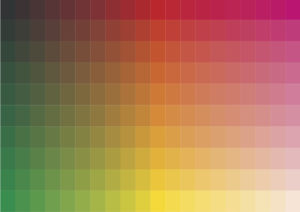 While there is always a rational explanation for your work titles (AST075 for your 75th acrylic on canvas, PM031 for your 31st mural, etc.), the title of this exhibition – U+25A6 – has a rather more mysterious origin. Can you tell us more about it?
While there is always a rational explanation for your work titles (AST075 for your 75th acrylic on canvas, PM031 for your 31st mural, etc.), the title of this exhibition – U+25A6 – has a rather more mysterious origin. Can you tell us more about it?
I wanted an abstract title, but one that would still relate to the exhibition. So I used Unicode, a computer encoding standard that allows users to exchange text across languages. In Unicode, the title stands for a geometric shape, a square with orthogonal crosshatch fill, which brings us back to the grid (AM012-AM013-2017-©-Courtesy-Stéphane-Dafflon-et-Air-de-Paris-Paris-2).
Beyond these tools, it has been said that your art is a manifestation of an electronic, digital world. Would you agree ?
To some degree this might be true, although probably a little less today. The pace at which the world evolves is hardly in sync with my painterly research, which remains a very slow process. What is certain, however, is that it has influenced the development and the succession of my pieces, but also my work as a whole. But it’s only a tiny aspect of this world.
What is your relation to decor ?
I don’t see decor as a negative concept. In any case, I can hardly elude it since my initial intention when
developing this project was to produce an effect of spatial immersion on spectators.
le plateau, paris
22, rue des Alouettes, 75019 Paris
T +33 (0) 1 76 21 13 41 / www.fraciledefrance.com
Open from Wednesday to Sunday from2pm to 7pm.
Late Night Opening : the 1st Wednesday of each month, until 9 pm
The exhibition is supported by Pro Helvetia, Fondation suisse pour la culture and Fonds cantonal d’art contemporain, DIP,
Geneva.


